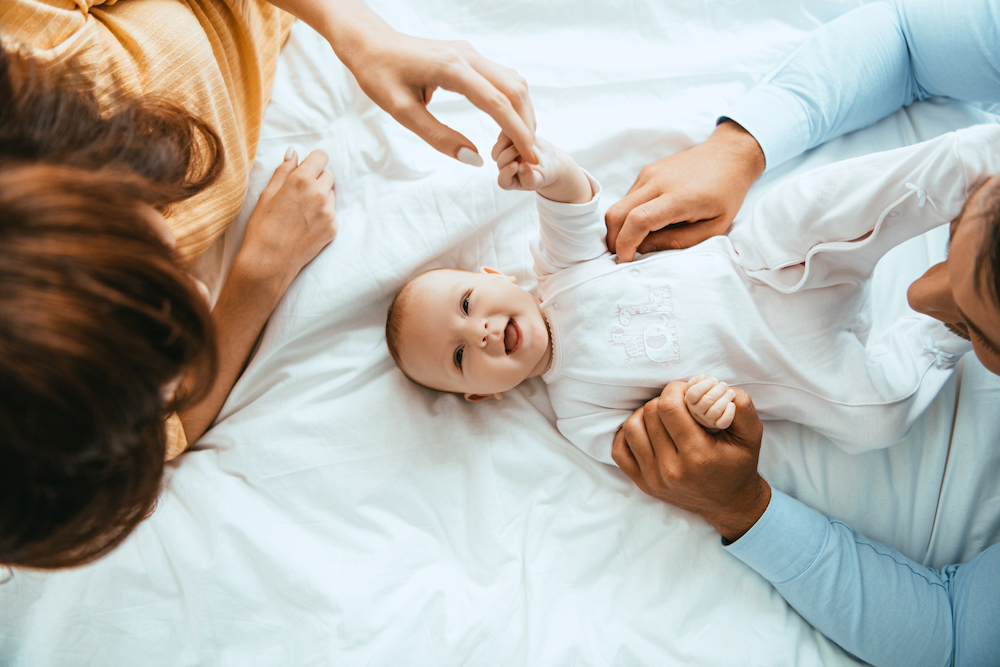Only children often get a bad wrap. But more and more parents are choosing to be “one and done.” These Portland families highlight the positives of having one child.

Many new parents will tell you that as soon as No. 1 arrives, the questions begin.
“Is this your first?”
“When will you try for another?”
“How many children do you have?”
The assumption, it seems, is that one isn’t good enough — or at least, it isn’t if you don’t want to permanently screw up your kid. But why? In a world where having any children is an increasingly challenging proposition, why is stopping at one still so taboo?
The answer, at least for some local families: It isn’t.
Choosing One
Rose Newberry’s daughter, Lily, is 3 and it seems like all of the moms of Lily’s friends are pregnant again.
“This is really coming up with her friends, so I’m being very clear about [telling my daughter], ‘You’re an only child,’” says Newberry. “There’s just not a ton [in media] celebrating an only child, so I try to be very intentional that this is a valuable family type.”
Newberry, who lives in Hillsdale with her husband and Lily, focuses on the trio’s identity as a “triangle family.” “We do talk about, ‘What’s good about that?’” she says. “Every family is special. What’s special about being just like this?”
Having one child wasn’t necessarily the plan; Newberry had a health scare when Lily was 9 months old. “I think we would have defaulted to two, but that pause, it kind of made us really look at this and ask, ‘Oh are we going to default?’”
Jennifer Kotley of Gresham can relate. She and her husband waited until their son, Misha, was 2 before deciding if they were done. “We were finally getting out of that fog of newborn and infancy and into a time where we felt we could reflect back on our experience a little bit better without being so exhausted,” she says.
When they did, they realized that for them, one was good.
“I realized what I wanted was more of my child, not necessarily another child. And I can’t replicate my baby. He’s amazing, but he’s the only one I’m ever going to have of him. So it didn’t feel fair to bring another child into this world,” she says. “Of course, I’d love that child no matter what, but the reasoning behind that shouldn’t be to replicate another child.”
Of course, Kotley knows that not everyone gets to choose if they’re one and done. Sometimes people have one child because they can’t afford another or aren’t able to conceive again. Kotley experienced that reality in her own family as a kid. “My parents did not want me to be their only child; that was not their choice,” she says.
Growing up, Kotely says this reality wasn’t necessarily spoken aloud but she felt it — a situation she wants to avoid for Misha: “If we’re going to have more, we’re going to have more. If we’re not, we’re not and we’re going to be open about that so that that unfilling longing isn’t present.”
“Every First is a Last”

The decision to stick with one isn’t without challenge. Kotley’s sibling-in-law is child-free by choice and since Kotley is an only child, her son will never have siblings or cousins in the traditional sense.
She often thinks about how that might impact Misha in the future. “If something tragic were to happen in our family, the level of support may not be as high,” she says. Of course, she adds, having a biological sibling isn’t any guarantee of future support.
For Newberry, her thoughts of a second child often involve milestones she wasn’t able to celebrate when pregnant with Lily during the COVID-19 lockdown.
“No one saw me,” she says. “I never saw the face of the person who delivered Lily. My mother never saw me. … So I have some grief around that.”
But, at this moment, the benefits of having one child are too high to give up — both for Newberry and her daughter. “I don’t think she’s connecting the dots, but I know that she likes going home to no siblings. She really likes the peace and quiet, and decompressing from school or classes.”
Kotley sees the same in Misha. “I have one human I can wholly dedicate my day to,” she says. “Whatever he wants to do, we can do that.” The joy of such focus can be profound. “I really get to fully dive into the special things that he’s doing every day,” she adds. “I have the ability to devote my full attention to that rather than manage another developing human.”
Seeing your only child grow can also be bittersweet, adds Newberry. “Every first is a last,” she says. “I would give anything to go back to the beginning and do baby Lily again knowing that it all works out.”
Myth vs. Reality
We all know the myth of the only child: the lemon of a kid who doesn’t know how to interact with others because there’s nobody their age at home.
How did this myth start? Blame the ’80s. A crop of research done during that decade and the 1990s led to many of the misbeliefs we have about only children, says Jana Meinhold, Ph.D. and associate professor and program director of Child, Youth and Family Studies at Portland State University (PSU).
Meinhold says that surveys conducted at the time were framed in such a way that they “really created a skewed perception of what it meant for a child to grow up as an only.” The resulting misconceptions permeated U.S. culture but, Meinhold says, they aren’t “showing up in our current research at all.”
More modern studies find that only children have “full functioning access” to friends, cousins, and other family members, who do much of the socialization that siblings might otherwise do.
“Those kiddos grow up and they find those social attachments,” says Meinhold. “In fact, a lot of the newest research is really talking about how onlies oftentimes show more creativity in how they engage academically and with the world. That’s really negating a lot of that negative ’80s and ’90s research.”
The lingering only-child stereotype is so strong that it may be surprising how many onlies there are. In 2021, one-child households in the European Union accounted for 49% of households with children — 10% points higher than the second most popular makeup (two children).
Only-child families also account for the largest group in Canada; 45% of families have one child, according to the 2021 Canadian Census. There’s even been a shift in the U.S. These days, one-child families outnumber two-child families — and have for several decades. The average family size in the U.S. has gone from 3.67 members in 1960 to 3.17 in 1988 to 3.13 in 2022.
In any conversation about family size, however, Meinhold advises caution. There are often cultural factors that influence how many children a person decides to have.
“The pressure just may be much higher especially when [having multiple children] is something that’s honored in culture,” she says. “That’s going to look and feel different.”
But there’s no denying that an increased cost of living, rising maternal age and fears around climate change are all contributing to a new normal.
A Family’s Choice
More time. More energy. More money. All are factors that may influence a family’s decision to have a single child, but PSU’s Meinhold says there’s another, too.
“I cannot have this conversation and not talk about social media and the pressure that parents feel to be ‘the perfect parent,’” she says. From the “right” toys to the “right” clothes, the added stress is real, says Meinhold, and it may be changing how people feel about having multiple kids.
“There are so many more voices out there now about what parenting should look like,” she says. “There’s a lot of pressure, and everyone has advice. Those things play out in our decision-making around having another child.”
That decision-making may not happen overnight.
“Take the time to sit with not knowing and allow yourself to be in that phase,” Kotley says. “It’s OK to not really be sure.”
She also encourages asking other families about their experiences, whether in-person or online. “Talking to people who have siblings or have multiple children was an eye-opener,” she says. “Internally, [I’ve been] able to look and be like, ‘Yeah, that’s just really not the path for me.’ It’s reaffirming.”
Of course, family size is, ultimately, a family choice.
“Make your decision for you and your family,” says Newberry. “A three-person family is still a family worth celebrating, and if it’s right for you, it’s right for you.”
Media Staring Onlies
Books
Amelia Bedelia series by Peggy Parish
What’s So Bad About Being an Only Child? by Cari Best
Ivy + Bean: One Big Happy Family by Annie Barrows
Jessica by Kevin Henkes
Saturday by Oge Mora
Little Sunshine by Julie Marie
Movies and TV Shows
Inside Out
Moana
Turning Red
Coraline
Finding Nemo
Luca
Raya and the Last Dragon
Trolls
Gilmore Girls
- Place Your Order for a Holiday Pie Here - October 17, 2024
- Yes, Traveling on Public Transit with Kids is Doable. And Fun! - September 12, 2024
- Here’s Why These Portland Families Are One and Done - September 3, 2024
